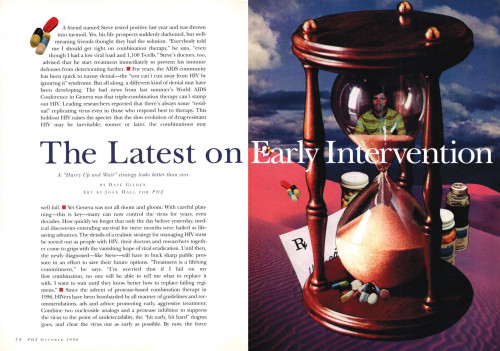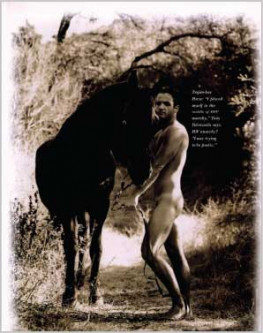For the past three decades, POZ has chronicled the HIV epidemic in the United States and around the world. The magazine has explored the highs and lows in the ongoing battle against HIV and tackled issues often ignored by other media outlets. When the April/May 1994 issue launched, the protease revolution was still on the horizon, and millions of people across the globe were dying of AIDS-related illnesses. POZ became a lifeline for many of our readers, providing access to critical information about the prevention, care and treatment of HIV.
Throughout its publication, POZ has also shared personal stories of survival as well as loss. POZ has given people hope, not only showing those living with HIV that they aren’t alone but also empowering them with the knowledge and courage to live with dignity.
As we look back at the history of the HIV epidemic, it often seems that the more things change, the more they stay the same. We’re still battling stigma, homophobia, racism, sexism, homelessness, addiction and poverty. But today, thanks to lifesaving medications, we have the tools to prevent HIV, and most people with the virus can have a healthy life. While the end of the epidemic might not be imminent, as we look back at some of POZ’s coverage over the past 30 years we can see perseverance, progress and a promising future.
Pedro Leaves Us Breathless

When Pedro Zamora graced the cover of our third issue, he had already won the hearts of millions as one of the first openly gay men living with AIDS to appear on TV. As a member of the cast of the third season of MTV’s The Real World, set in San Francisco, the charismatic Miami-based AIDS educator put a face to a disease that many people still feared. “I thought it would be a great way to educate people,” he told POZ. “I thought being on the series would be a great way to show how a young person actually deals with HIV and AIDS.” Zamora drew international attention to the epidemic. He died on November 11, 1994, hours after the airing of the final episode of the reality series and a few months after the issue was published.
Do You Believe in Magic?

In 1991, professional basketball player Earvin “Magic” Johnson Jr. abruptly retired after announcing at a press conference that he had HIV. Johnson’s declaration stunned the world. He vowed to battle the deadly disease and become a national HIV spokesman. Although Johnson shone a spotlight on the epidemic, many AIDS activists—including Larry Kramer—felt he wasn’t doing enough. POZ caught up with Johnson for our June/July 1996 issue. He had recently returned to play for the Lakers before retiring for the third and final time. “My focus is to educate and bring awareness to the AIDS issue and to raise money to support HIV/AIDS organizations,” he told POZ. “Larry Kramer has been very effective as an activist and has done many wonderful things for people with HIV and AIDS. But I decide what my role will be, not anyone else.” Johnson and his wife, Cookie, have continued to raise awareness about HIV; last September, both were honored by the Elizabeth Taylor AIDS Foundation for their efforts.
The Latest on Early Intervention

When effective combination therapy to treat HIV became available in 1996, it was justifiably hailed as a miracle. However, two years later, at the International AIDS Conference in Geneva, it was revealed that even individuals responding well to therapy have residual replicating virus, raising concerns about the potential development of drug-resistant HIV. Our October 1998 issue explored the evolving challenges in HIV treatment and the uncertainty surrounding the optimal treatment approach. As researchers continued to seek answers on when to start treatment, how long it should be continued and when to switch drugs, individuals living with HIV had to make difficult decisions about how to best manage their virus—considering factors like overall health, viral load and CD4 count—in an effort to save future drug options.
They Shoot Barebackers, Don’t They?

In November 1997, HIV-positive gay activist Tony Valenzuela gave an honest and impromptu speech about his sex life at the Creating Change Conference in San Diego. His frank acknowledgment that he enjoyed condomless sex (known as barebacking) caused an uproar and inflamed community leaders. POZ caught up with Valenzuela for our February 1999 cover, for which he cheekily agreed to pose bareback on a horse. “I wanted to get rid of shame by being vocal about the things so many positive men do silently,” he told POZ. “I certainly wasn’t out to encourage anyone not to use condoms.” By speaking his truth, Valenzuela created a space for other gay men to do so as well.
Side FX

In 2000, there were 14 antiretroviral drugs approved by the Food and Drug Administration for the treatment of HIV. Unfortunately, most of those drugs caused troubling side effects, including abdominal pain, aggressive behavior, anemia, bone loss, buffalo humps, diabetes, diarrhea, fatigue, gas, insomnia, kidney stones, muscle loss, nausea, neuropathy, pancreatitis, paranoid reactions, severe depression, taste perversion, vomiting and much more. POZ’s September 2000 issue featured “A User’s Guide to Everything You Never Wanted to Know About Med Meanies,” which aimed to help people living with HIV cope with the awful side effects by providing a variety of useful tips.
Missing in Action

Our October 2000 issue paid tribute to AIDS activist Stephen Gendin, who died suddenly after starting treatment for AIDS-related lymphoma. Four versions of the cover captured Gendin in various stages: empowered and marching with ACT UP New York in 1990; sexy as he posed in Hawaiian sand in 1996; sick and carrying his beloved dog, Zoom, in 1998; and deceased in 2000. Gendin’s death was a huge loss for the HIV community, for which he’d spent 15 years as a fierce advocate. He’d been a member of ACT UP, a founder of the Community Prescription Service and a contributing editor at POZ, where his writing was sometimes controversial but always painfully honest.
Life vs. Meth

Crystal. Tina. Ice. Sparkle. By the early 2000s, an alarming number of gay men were being drawn to an alluring drug known by many names: crystal methamphetamine. Cheap, long-lasting and readily available, the drug boosts self-esteem and produces intense sexual experiences. Its popularity and association with condomless sex and other risky behaviors also contributed to a rise in new HIV cases. Our July/August 2002 cover story was written by a man in recovery for crystal meth addiction, who shared his personal struggles with the drug, detailing a descent from recreational use to injecting the drug regularly. Despite the destructive consequences of meth use, including isolation, paranoia and a decline in physical and mental health, the party drug continues to thrive in the gay community—and destroy the lives of many who use it.
PrEPing for Sex

POZ first mentioned pre-exposure prophylaxis—or PrEP—as an HIV prevention method in the July/August 2003 issue. The idea of prescribing antiretrovirals to people who were HIV negative to prevent the virus was a bitter pill for some in the community, who felt money would be better spent on treating people living with HIV. Approved in July 2012, PrEP, which reduces the risk of acquiring HIV via sex by about 99% but does not protect against other sexually transmitted infections, ignited a new debate about barebacking. Some saw PrEP as a welcome opportunity to ditch condoms and embrace a sexual freedom lost to AIDS. Others worried about drug resistance. Two years after PrEP’s release, POZ took an in-depth look at the drug’s rollout and future in our October/November 2014 issue.
Perfect 10

On a cold morning in March 2004 at the New York City restaurant Florent, POZ gathered a group of people living with HIV who had agreed to literally bare all for the cover image of our 10th anniversary issue. For the occasion, POZ enlisted the artist Spencer Tunick, known for his large installations of naked bodies. Within minutes of stripping down, a sense of solidarity pervaded the restaurant. One participant noted, “We became one, without fear, our souls without judgments.” The moving experience was memorialized in the documentary Positively Naked, which was released in 2006 and is available to stream on Max.
Senior Class

POZ celebrated both the 80th (in the November 2004 issue) and 90th (October/November 2014) birthdays of Nello Carlini, who was a proud member of San Francisco’s gay community. Carlini was 71 years old when he tested positive for HIV while abroad. He returned home to San Francisco, where he overcame Pneumocystis pneumonia, not to mention anal cancer. Carlini acted at Theatre Rhinoceros, the city’s LGBT theater company, and was a president of the San Francisco Gay Men’s Chorus. Among the guests at his 80th birthday party were friends, family and a singing gorilla birthday-gram. His birthday wish at his 90th birthday party? “I wish I were able to kick my heels a little bit, because if I could,” he said, “I’d still be traveling.” Carlini died in 2018 of complications of lung cancer.
Just Married

POZ began following Shawn Decker when he started blogging about HIV in 1996 at age 22. Decker, who contracted HIV from blood products used to treat hemophilia, was diagnosed with the virus at age 11. In total, he has appeared on eight POZ covers, including a few with his wife and fellow HIV educator, Gwenn Barringer. (The couple met while waiting in line to meet Ryan White’s mother, Jeanne White-Ginder.) POZ was thrilled to have scored an invite to the serodiscordant couple’s wedding on October 23, 2004, in Charlottesville, Virginia; we shared their wedding photos in our January 2005 issue. “We use our relationship to break down some of the myths about HIV transmission and condom use,” Decker told POZ in 2013, “and we put our personal life out there in hopes of educating people.” The dynamic duo will celebrate their 20th wedding anniversary this fall, proving that the couple that advocates together stays together.
Southern Discomfort

“America’s Hidden HIV Epidemic” declared a June 2017 New York Times Magazine article spotlighting the alarmingly high HIV rates among Black gay and bisexual men—particularly in the U.S. South. Earlier that year, POZ covered the same topic in our January/February 2017 cover story. But it wasn’t the first time we sounded the alarm about the raging HIV crisis in the South. Our July 2005 cover story shared how factors such as extreme poverty, government funding shortfalls and HIV-related stigma and discrimination complicated the prevention and treatment of HIV and gave rise to disproportionately high rates of the virus in the area. In our January/February 2011 issue, POZ highlighted the work of HIV advocates in the South who were working to overcome the barriers to care. The HIV epidemic in the South has never been hidden—most of the country just hasn’t been paying attention to it.
Anonymous No More

It’s not always easy to tell someone you are living with HIV, so imagine announcing it to the world by appearing on the cover of a magazine. That’s exactly what Regan Hofmann did when she took hold of the reins of POZ as its first female editor-in-chief. For four years, Hofmann, who had lived with HIV in secret for nearly a decade, had written the Anonymous column in the magazine. “I am no longer afraid to say I have HIV,” she proclaimed on the cover of the April 2006 issue. “I believe our stories can change the world.” Indeed, they have.
More Than Just a Number

In 2005, POZ started including surveys in the magazine to ask readers about various topics related to HIV. In the December 2007 issue, we tallied your answers to create a snapshot of what it was like to live with HIV in America. “The numbers tell an amazing story about your lives, your guilty pleasures, your romances, your health care, your treatment choices, your beliefs, your fears, your hopes,” read the introduction. More than 100 surveys later, POZ continues to take the pulse of the HIV community on topics such as treatment, side effects, aging, stigma, discrimination and more.
Service Interruption

When 25-year-old Jeremiah Johnson was forced to leave the Peace Corps after testing positive for HIV in Ukraine, he didn’t fancy himself an HIV activist. But he became just that when he enlisted the help of the American Civil Liberties Union to sue the Peace Corps for his dismissal. Thanks to his efforts, the organization officially revised its policy, agreeing to no longer terminate volunteers because they have HIV. Unfortunately, the new policy was not strictly enforced, as evidenced by our July/August 2018 cover story, which shared the stories of other volunteers dismissed from the Peace Corps after testing positive for HIV abroad. It’s a stark reminder that the need for advocacy never ends.
POZ/AIDSMeds Drug Chart

In the early days of HIV combination therapy, treatment involved taking a handful of pills at various times of the day. Some medications needed to be taken with food and some without, and keeping track of the various side effects and interactions was a feat unto itself. Thankfully, over time, antiretroviral options became easier to tolerate, and the pill burden lessened for many. In December 2008, POZ (along with our sister brand AIDSmeds) created a quick-reference HIV drug chart detailing available medication options, including dosing and dietary restrictions. Six years later, the POZ HIV Drug Chart became an annual feature in our July/August issue.
Wonder Women

In the early 1990s, ACT UP created the slogan “Say It: Women Get AIDS” because so few people knew that women could get HIV. In 2010, HIV was the leading cause of disease and death among women ages 15 to 44 worldwide. Historically, women have been uniquely vulnerable to HIV due to various social, biological, psychological, political and economic factors. Our March 2010 issue featured first-person accounts of seven resilient women living with HIV in the United States not only facing their own challenges with the virus but also actively supporting other women contending with similar struggles. Sisterhood is indeed powerful.
Patient No More

In June 2011, POZ featured Timothy Ray Brown aka “the Berlin Patient” on the cover. Diagnosed with HIV in 1995, Brown was living in Berlin when in 2006 he was diagnosed with leukemia. To treat the blood cancer, he underwent two bone marrow transplants using stem cells from a donor with a rare genetic mutation that blocks HIV from entering cells. In 2008, following chemotherapy and radiation, Brown’s cancer was in remission, and his newly rebuilt immune system had eradicated his HIV. His story gave hope to millions of people living with the virus and spurred the scientific community to renew its search for a cure. Sadly, Brown died in 2020 after battling a recurrence of leukemia.
Criminal Injustice

Over the years, POZ has tackled the issue of HIV criminalization in various ways, but in the June 2012 issue, we featured three new faces in the HIV decriminalization movement: Robert Suttle, Nick Rhoades and Monique Moree. Each of them had recently faced criminal charges related to their HIV status and had shared their stories in HIV Is Not a Crime, a short documentary by POZ founder Sean Strub. Strub had recently launched the Sero Project, part of a growing national movement to reform out-of-date laws that prosecute people based on their HIV-positive status. Soon, more and more advocates began to mobilize around HIV criminalization, and in May 2014, Iowa became the first state to repeal its HIV-specific criminal statute.
Not Lost in Translation

Boston-based Devarah “Dee” Borrego was the featured POZ Hero in our April/May 2013 issue. The transgender advocate, who was diagnosed with HIV in 2005, a few weeks after her 21st birthday, shared her story in the hopes of empowering others and was photographed confidently smiling in a white button-down shirt and dark brown pencil skirt. According to a 2022 article in The Guardian, Dee’s photo caught the eye of an inmate at a men’s maximum-security prison in Missouri who had a subscription to POZ. Jessica James Hicklin had known she was a woman since age 8 but had never heard the word transgender until she flipped through the pages of POZ and saw Borrego’s photo. She thought, There I am. That’s me. Hicklin became the first transgender inmate in Missouri to successfully sue for the right to access hormones. She was released on parole in 2022.
The Sound of Stigma

When AIDS advocate, author and blogger Mark S. King asked whether he could use yellow paint as a prop for his upcoming POZ cover shoot, what choice did we have but to say yes? The resulting images appeared in our June 2013 issue along with King’s moving essay on why HIV-related stigma persists among gay men. “The more HIV treatments improved,” King wrote, “the wider the viral divide became. Our mutual resentments and jealousies worsened.” King’s powerful photos and essay struck a chord with many of our readers. “The Sound of Stigma” remains one of the most commented-on articles on POZ.com.
The POZ 100: Celebrating Unsung Heroes

We created the POZ 100 list in 2010, but the 2013 POZ 100 marked the first time the list was made up entirely of advocates living with the virus. It was also the first time the honorees were nominated directly by the community. Instead of highlighting familiar, high-profile advocates, POZ celebrated unsung heroes in the community who were making a difference in the fight to end the epidemic. From volunteers and policy advocates to educators and case managers, the list represented a diverse spectrum of people living with HIV who inspired us with their commitment to the cause.
Against All Odds

Most of us take risks every day without even thinking about it—let alone trying to wrap our heads around the odds associated with those risks. But when it comes to HIV risk, people can be preoccupied with percentages. And the numbers don’t always reflect the many factors that can raise or lower one’s risk. In the April/May 2014 issue, POZ drilled deep into the data and explained the differences between cumulative risk, absolute risk and relative risk. The underlying ideas and messages in the article remain relevant today, but, with so many more HIV prevention tools, the odds may be more in your favor. “Numbers can be a good tool for helping people understand risk,” said James Wilton, of the Canadian AIDS Treatment Information Exchange, “they just need to be packaged with a lot of information.”
Black Lives Matter

The Black Lives Matter movement dates back to 2013 when the social media hashtag #BlackLivesMatter first appeared following the acquittal of George Zimmerman for the killing of Trayvon Martin. It gained momentum after the killings of Michael Brown, Eric Garner and Rekia Boyd, among others. In our January/February 2016 cover story, POZ delved into the impact of trauma in the Black community, drawing parallels between the systemic violence Black people face and the trauma people living with HIV experience. POZ explored the shared lessons and strengths of the Black Lives Matter movement and the HIV activism community, advocating for an intersectional approach to help overcome the systemic challenges both communities face.
Quest for Healing

Our March 2018 cover story examined the challenges American Indians and Alaska Natives (AIs/ANs) face in dealing with HIV, highlighting the cultural, economic and logistical obstacles they encounter when it comes to testing and accessing HIV care and treatment. According to the Centers for Disease Control and Prevention (CDC), annual HIV diagnoses in the United States declined by 19% percent among the general U.S. population from 2005 to 2014 but rose by 19% among AIs/ANs. Lack of health insurance, high rates of poverty, high rates of exposure to violence and crime, and historical and intergenerational trauma are some of the factors that contribute to health disparities among Native Americans. This is all complicated by the fact that each tribe has its own policies and norms informing their approach to HIV.
Understanding Undetectable = Untransmittable

In 2008, a consensus statement by Swiss HIV experts asserted that individuals with HIV who maintain an undetectable viral load through treatment cannot transmit the virus during sex. Early proof came in 2011, when study results from the randomized trial HPTN 052 found that treatment reduced HIV transmission in serodifferent couples by at least 96%. Further proof came via the results of the 2018 PARTNER2 study. Yet this incredible news was not reaching most people living with HIV. Our March 2019 issue highlighted the efforts of the U=U (Undetectable Equals Untransmittable) campaign, which aimed to simplify and amplify the message. Launched in 2016 by the Prevention Access Campaign, U=U overcame skepticism and gained widespread support, significantly transforming the perception of HIV transmission risk, to the delight of people living with HIV everywhere.
COVID-19 and HIV

When the COVID-19 pandemic emerged in early 2020, memories of the early days of AIDS flooded back for many in the HIV community. Our July/August 2020 cover story explored the new uncertainties facing those living with HIV, such as the risk of contracting COVID, potential impacts on accessing HIV care and the effects of social isolation and financial instability. While those with compromised immune systems are generally more susceptible to infections, early reports suggested that individuals on antiretroviral treatment with an undetectable viral load and a near-normal CD4 count did not appear to be at higher risk for severe COVID. As the world grappled with a new virus, the HIV community worked to find a balance between maintaining COVID precautions and continuing its HIV treatment and prevention efforts, while also addressing the structural inequities and disparities highlighted by both pandemics.
Latinos in the South

In our October/November 2022 issue, POZ focused on the challenges that Latinos in the Southern United States face regarding HIV, spotlighting barriers such as language, confidentiality, financial stability, discrimination, immigration status, health insurance, family and religion. It also showcased the efforts of the Latino Commission on AIDS program “Latinos in the South,” which addresses these issues through capacity building, language justice work, leadership institutes and advocacy on topics such as HIV decriminalization and Medicaid expansion. Despite the numerous hurdles, advocates in the Southern states are working compassionately to meet the challenges and create affirming and welcoming spaces for Latinos to access HIV care and treatment.
DoxyPEP 101

Although PrEP is highly effective at preventing HIV, ditching condoms can often lead to other STIs. In our January/February 2024 issue, POZ provided the 411 on doxyPEP, a morning-after antibiotic pill that lowers the risk of chlamydia, gonorrhea and syphilis. In October, the CDC issued its first national doxyPEP guidelines, recommending a new way to have safer sex. As they did when PrEP emerged, skeptics worried about drug resistance and an increase in condomless sex, even though effective, evidence-based prevention options can help slow the spread of STIs and HIV. DoxyPEP is simply another tool in the healthy sex toolbox.
Live to Tell

Considering her long history of AIDS activism, it wasn’t hard to justify our love for Madonna by putting her on the cover of our March 2024 issue. The pop star was in the midst of her Celebration tour, which includes a moving tribute to individuals who died of AIDS-related causes. In 1987, the Material Girl performed the first AIDS benefit concert at Madison Square Garden in New York City, raising $400,000 for amfAR, the American Foundation for AIDS Research. Her 1989 album, Like A Prayer, included an insert with facts about AIDS; her 1992 album, Erotica, included songs dedicated to those lost to the disease. In 2006, Madonna cofounded Raising Malawi, a nonprofit that helps raise awareness about the critical needs of the country’s children who have lost one or both parents to AIDS. We cherish the fact that Madonna has opened her heart through-out her career to uplift the HIV community.
Visit poz.com/magazines to read the full archive of POZ magazine.







Comments
Comments